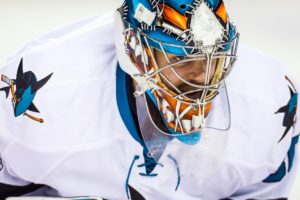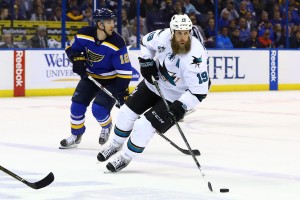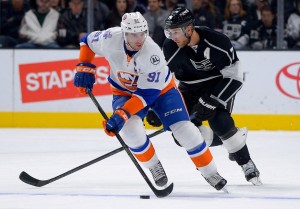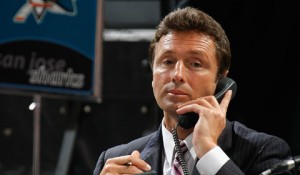The San Jose Sharks sit comfortably atop the Pacific Division with the regular season now entering the home stretch. At this point, the Sharks should prepare for the playoffs. But with the trade deadline approaching, could a trade assist them in their playoff pursuit?
Possibly. Maybe.
For the Sharks, this trade deadline is a case of ‘go big or stay home’. There is no point in getting a middle-tier player at any position.

The Sharks are not likely to improve on their goalie situation. They have a locked-in starter in Martin Jones. The backup, Aaron Dell, has been excellent.
Nor are they likely to get better on defense, with one of the best group of blueliners in the league. For roughly 75 percent of any given game, either Brent Burns or Marc-Edouard Vlasic is on the ice.
The forward group is easily the deepest it has ever been in San Jose. There is no point to bringing in a middle-tier forward. The Sharks have plenty of these players as it is. The fourth line the Sharks have been rolling recently is a combined plus-8 on the year. In the most recent game against Vancouver, plus-12. And this was without Ryan Carpenter, Joonas Donskoi or Timo Meier in the lineup.
The only spot for the Sharks to really move the needle is with a top-tier forward. The Sharks need here, however, is for both the playoff run this season and for the longer term.
An Issue in the Middle

If there has been one constant over the past dozen seasons for San Jose, it is this: Joe Thornton is the top player on the team. Thornton, with his Hall of Fame resume, has been the key to everything the Sharks have accomplished. But this is changing.
The Sharks have needed an elite center to compete in the Pacific Division. Ryan Getzlaf, Anze Kopitar and Henrik Sedin have all been around for a decade or more. The newest entry into the elite club is Connor McDavid, who may turn out to be the best of all.
Thornton may remain a good NHL player for several more seasons, but whether he is the right person to matchup against these other top centers is a different issue.

In the dozen games this season against Edmonton, Los Angeles and Anaheim, Thornton has six points, all assists, and is a minus-2. He has been a plus player in only one of these dozen games. He is competing against these players. But he and his line are no longer winning. This matters. The Sharks will not get out of the West without playing against at least one of these teams. And if the top line isn’t at least holding its own against the other teams’ elites, the Sharks probably aren’t winning.
Two Challenges, One Shot
If the Sharks are going to attempt to upgrade the roster for the playoffs, they should address the issue with the top center spot in the same deal. There are only so many tradable assets that San Jose can offer. The goal is to get the elite player while also leaving the handful of top-tier Sharks in place.
The Sharks would be wise to put their strong middle-tier players, solid prospects and draft picks together for a single elite piece, rather than parse them for multiple, lesser players.

The recent trade of Patrick Eaves illustrates this. The Anaheim Ducks parted with a draft pick to get Eaves from the Dallas Stars. The draft pick will be determined later, but will either be a first or second round pick. For now, though, neither draft pick can be used in a trade.
San Jose could make a trade which includes these sorts of high draft picks for an Eaves-level player. But in the process, they would lose some of the critical assets needed to acquire an elite player. While Eaves is a good player, the Sharks need a bigger catch.
The Main Course
Elite players do not get moved easily or cheaply. Only a small number of players can fit the role San Jose needs. Unlikely as these trades might be, so was the trade which landed Thornton.

Two players which meet the Sharks criteria are Patrice Bergeron and John Tavares. There are good reasons for their current teams to keep these players. There are, however, reasons which might make them available for trade.
Either player would be a terrific fit in San Jose. I covered some of the trade issues with Tavares a few weeks ago in a recent article.
Bergeron, now 31, is headed into the back half of his deal, where the relative value is likely less. The deal runs through age 36. For a superb defensive center, the Pacific Division is the ideal spot. Kopitar, Getzlaf and McDavid are all better than any center in the Atlantic Division (except perhaps the rarely seen healthy Steven Stamkos). Bergeron would fill a key need in San Jose.
Spending Once

Though I would expect to pay more for Tavares than Bergeron, either player will be expensive. Perhaps up to six assets could be required, combining established players, promising prospects and high draft picks.
Established players likely to be discussed in a deal are Justin Braun and Tomas Hertl. Top prospects (some with limited NHL experience) like Timo Meier, Tim Heed, Mirco Mueller and Kevin Labanc will also be under consideration. And expect at least one first-round pick to be used, maybe more than that.
Fortunately, Doug Wilson has an excellent sales pitch to make. The Sharks top farm team, the AHL’s San Jose Barracuda, are in first place and on a 14-game win streak. If a team is interested in top prospects, the Barracuda are prime feeding ground.
If the Sharks are going to part with major assets, they need to make sure they address both major challenges. It is unlikely they have enough assets to trade for a very good player to help the Stanley Cup run, then trade again for a player who can fill Joe Thornton’s skates on the top line.

Getting both objectives met in a single deal should be Doug Wilson’s goal. Wilson has swung trades to acquire top players before, including Thornton, Dan Boyle and Burns. Also helpful, Wilson has made deals in recent seasons with the executives in Boston (getting Martin Jones) and New York (giving Tyler Kennedy).
There are few players the Sharks should consider acquiring. Instead of settling for a modest incremental improvement, the Sharks should reserve their resources for the right opportunity. If the opportunity does not materialize, the Sharks should sit out this important trading window.
Zeke’s Notes
In my prior article, I suggested the Sharks would be wise to increase the playing time of specific younger players, while taking away time from some of the older veterans who have carried the load. If the first game back following the mandatory break is any indication, this might be a strategy the team adopts. Joe Thornton saw 13:48 minutes of ice time, his lowest total of the year for a full game. Patrick Marleau saw 14:27 and Joe Pavelski 15:40, his second lowest total of the season. Fourth liners Micheal Haley and Barclay Goodrow, both pitched in a solid 12 minutes. Two youngsters, though, saw a notable uptick. Chris Tierney was 16:51 and Tomas Hertl 18:33. This sort of ice time shift can help the Sharks top players stay stronger for the playoffs.